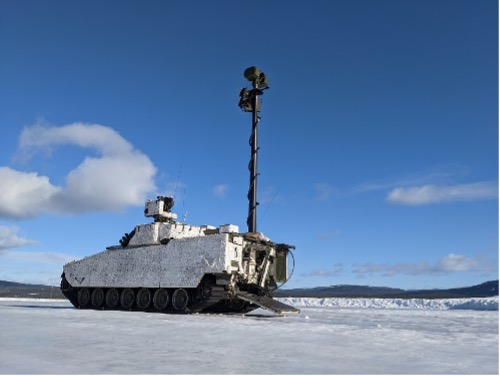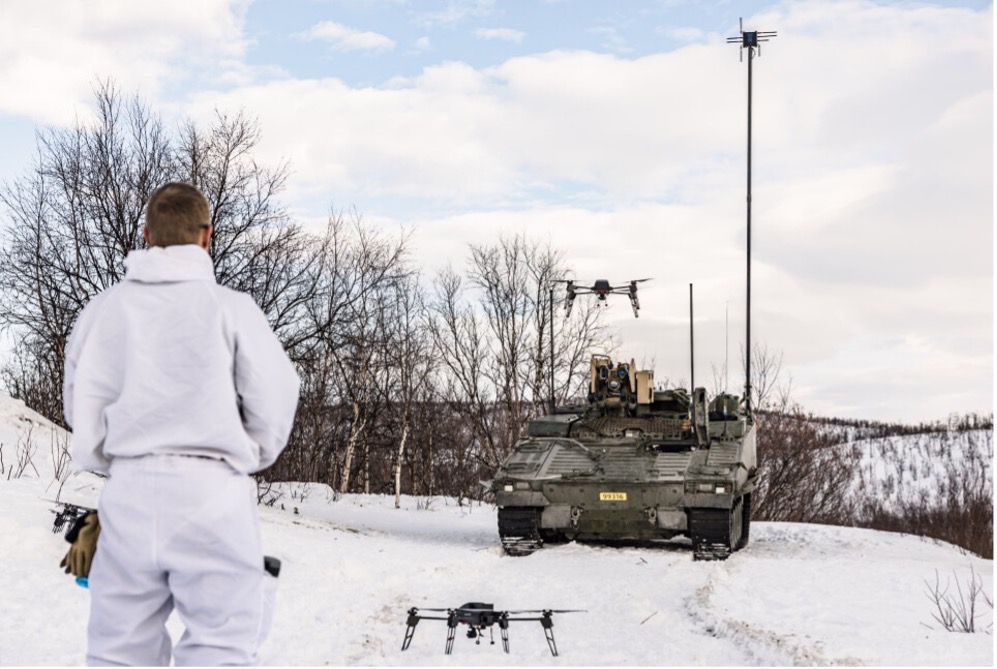The rapid advancement of military technology continues to transform the operational landscape of modern warfare. Cavalry operations (CavOps), traditionally focused on reconnaissance and rapid manoeuvre, now increasingly rely on sophisticated sensor systems and unmanned aerial vehicles (UAVs) to maintain battlefield superiority. This article explores the integration of the Observation Targeting and Surveillance Systems (OTAS) and drone swarms controlled from the CV90 infantry fighting vehicle (IFV), coupled with the Digital Aided Fire Solution (DAFS). Focusing on the Norwegian Army’s implementation efforts, it
evaluates how this technological fusion enhances targeting capabilities and situational awareness whilst critically examining the cost-effectiveness and tactical trade-offs associated with tethered drone systems.
Cavalry Formations and Their Operational Concepts: The Case of Porsanger Battalion
A cavalry formation primarily conducts its missions as part of enabling operations (US ARMY, 2016, p. 12) . Enabling operations are operations that facilitate a transition to either offensive or defensive operations (NATO Standardization Agency, 2009, p. 185) . Within this spectrum, a cavalry formation must be capable of conducting reconnaissance and security operations. Therefore, it is important to combine firepower, manoeuvre, and protection with the ability to identify targets.
Porsanger Battalion, within the framework of the Finnmark Brigade, is Norway’s only pure cavalry formation dimensioned for this role. Norway has chosen to use the CV90 platform for the concept development of such a cavalry formation. Similar to several Nordic countries, more are now recognising the platform’s utility in terms of adaptability and flexibility, acquiring the CV90 platform for their own armed forces (Ministry of Defence, 2025)
The CV90 Platform and OTAS Capabilities
The CV90 Infantry Fighting Vehicle (IFV), developed by BAE Systems Hägglunds and fielded by several NATO countries, is a modular, highly adaptable platform tailored for reconnaissance and combat operations in demanding environments. Its open digital architecture enables integration of advanced mission systems, transforming the vehicle into a networked sensor and command node. A key capability enhancer is the Observation Targeting and Surveillance Systems (OTAS), which significantly improves the CV90’s effectiveness in surveillance, target acquisition, and precision engagement.

In the Norwegian CV90 reconnaissance configuration, OTAS incorporates the Chess Dynamics Hawkeye Modular Mission Pod (MMP); a mast-mounted, multi-sensor suite combining electro-optical and infrared sensors, a high-power daylight camera, a long-range laser rangefinder (>30 km), a laser pointer, and a compact radar system for target detection and tracking. This radar capability provides persistent surveillance and allows for wide-area situational awareness, even in degraded visual environments. The system meets Category 1 Target Location Error (TLE) standards, the highest level of geolocation accuracy in NATO, enabling precise engagement at ranges beyond 20 km. Integrated into either a local Combat Management System (CMS) or a broader Battlefield Information System (BIS), and enhanced by AI-powered classification and tracking tools, OTAS delivers near-real-time threat detection and dissemination across the network. This dramatically increases the unit’s operational autonomy and survivability in fast-paced, sensor-dense battlespaces (Chess Dynamics, 2023) .
Drone Swarms and Digital Fire Solutions Integration
Integrating drone swarms directly into the CV90’s command ecosystem represents a fundamental shift in how reconnaissance and targeting operations are conducted. Unlike conventional UAV operations that depend on external ground control stations, deploying and controlling drone swarms from within the vehicle reduces communication latency and enhances tactical responsiveness (Edvardsen & Hansen, 2024) . These swarms provide persistent surveillance, automated target recognition, and post-strike damage assessment, significantly expanding the CV90’s sensor reach and enabling a layered reconnaissance effect
that complements the onboard OTAS suite.
The sensor data collected from both OTAS and UAVs is fused within the Digital Aided Fire Solution (DAFS), a system developed to streamline and automate fire control processes. DAFS integrates real-time targeting information, generates precise firing solutions, and enables rapid engagement with minimal operator input. It is fully interoperable with NATO digital joint fires procedures, supporting seamless coordination between indirect fire assets and frontline sensors (Teleplan Globe, n.d.) . This digital fusion reduces sensor-to-shooter timelines, increases first-round hit probability, and allows cavalry units to maintain a decisive tempo in dynamic combat environments, thus enhancing both lethality and survivability.
The sensor data collected from both OTAS and UAVs is fused within the Digital Aided Fire Solution (DAFS), a system developed to streamline and automate fire control processes. DAFS integrates real-time targeting information, generates precise firing solutions, and enables rapid engagement with minimal operator input. It is fully interoperable with NATO digital joint fires procedures, supporting seamless coordination between indirect fire assets and frontline sensors (Teleplan Globe, n.d.). This digital fusion reduces sensor-to-shooter timelines, increases first-round hit probability, and allows cavalry units to maintain a decisive tempo in dynamic combat environments – thereby enhancing both lethality and survivability.

Implementation in the Norwegian Army
The Norwegian Army’s modernisation efforts, particularly under the Future Land Combat System (FLCS) program, prioritise digitalisation, automation, and enhanced connectivity to prepare for high-intensity conflict scenarios. This aligns with strategic defence plans outlined by the Norwegian Ministry of Defence (2021, 2023) . The integration of OTAS and drone swarms on the CV90 platform supports these objectives by significantly improving sensor autonomy, decision-making speed, and combat effectiveness of mechanised cavalry units. Field trials and exercises, such as Arctic Strike 2024 and Nordic Response, have demonstrated that cavalry troops equipped with mast-mounted multi-sensor pods and UAV swarms controlled directly from the CV90 achieve superior situational awareness and more efficient target engagement compared to legacy systems (FFI, 2024) . By reducing sensor-to- shooter latency and enhancing the accuracy of targeting data, technologies like OTAS and the Digital Aided Fire Solution (DAFS) enable faster and more precise coordination of fire and manoeuvre. Moreover, the ability to operate UAV swarms directly from the vehicle facilitates decentralised operations, empowering smaller cavalry teams to operate with greater autonomy and lethality across dispersed battlefields.
Cost-Benefit and Tactical Considerations of Tethered Drones
A key component of modern military drone strategies is the use of tethered drones, which could be physically connected to the CV90 platform via cables that provide continuous power and secure communication links. This tethered connection offers extended endurance and enhanced resistance to electronic warfare measures such as jamming (Elistair, 2023). However, the tether inherently limits operational range and vehicle mobility, as the drone's flight radius is constrained by the physical length of the tether (Elistair, n.d.).
From a cost perspective, tethered drone systems involve not only initial acquisition expenses but also ongoing costs related to maintenance, operator training, and logistical support. These factors must be considered in a comprehensive cost-benefit analysis (HC Robotics, 2024) . The operational trade-off lies between the extended flight duration and electronic resilience tethered drones provide and their reduced tactical flexibility due to range and manoeuvre constraints (Elistair, 2023, n.d.) .
Risks and Limitations of Automation in Contested Environments
While automated fire control systems such as the Digital Aided Fire Solution (DAFS) enhance targeting speed and accuracy, they rely heavily on uninterrupted sensor data and robust communication networks. In contested electronic warfare (EW) environments, adversaries may deploy jamming, spoofing, or cyber-attacks to disrupt these networks and degrade system performance (Singer & Friedman, 2014) . Such disruptions risk causing delays, misidentification, or even system failures during critical engagements. To mitigate these risks, maintaining human oversight and intervention capability is crucial. Training programs emphasise operator proficiency in manual control and emergency procedures to ensure system resilience under compromised conditions (IISS, 2023) . The Norwegian Army’s approach reflects a balanced doctrine, leveraging automation benefits while ensuring human judgment and ethical considerations remain central, as fully autonomous targeting remains beyond current operational acceptance.
Conclusion
The integration of OTAS and drone swarms operated from the CV90 platform, supported by DAFS, represents a significant leap forward in cavalry operational capability. By enhancing real-time situational awareness, accelerating targeting cycles, and enabling precise engagements, these systems provide Norwegian cavalry units with a decisive edge on the modern battlefield. However, the incorporation of tethered drones introduces complex trade-offs related to cost, mobility, and vulnerability, demanding rigorous evaluation and adaptive doctrine development. Moreover, reliance on automated systems in contested electromagnetic environments underscores the continued necessity for human oversight and robust contingency planning.
As the Norwegian Army continues to evolve its Future Land Combat System, ongoing field experimentation, technological refinement, and operational feedback will be crucial to maximising these technologies’ potential. The balance between technological advancement and practical battlefield realities will ultimately determine the success of this omniscient evolution in cavalry operations.
References
Chess Dynamics. (2023, October 2). Chess delivers highest accuracy levels for Norwegian project. Chess Dynamics. https://www.chess-dynamics.com/news/chess-delivers-highest-accuracy-levels-for-norwegian-project
Edvardsen, A., & Hansen, B. A. (2024, April 9). Norway to invest in defense-oriented science and innovation in the North. High North News. https://www.highnorthnews.com/en/norway-invest-defense-oriented-science-and-innovation-north
Elistair. (2023, March 21). Tethered Drone Systems vs. Traditional Drones: What is the Difference?https://elistair.com/resources/general-information-about-tethered-drones/tethered-drone-systems-vs-traditional-drones-what-is-the-difference/
Elistair. (n.d.). What are the Differences Between Tethered & Traditional Drones?https://www.unmannedsystemstechnology.com/feature/what-are-the-differences-between-tethered-traditional-drones/
FFI. (2024, May 13). Tested new defense technology during Arctic Strike 2024. https://www.ffi.no/en/news/tested-new-defense-technology-during-arctic-strike-2024
HC Robotics. (2024, August 27). The Utility of Tethered Drones for Defence Services. https://hcrobo.com/the-utility-of-tethered-drones-for-defence-services/
IISS. (2023). The Military Balance 2023. International Institute for Strategic Studies.
Ministry of Defence, N. (2021). Future Acquisitions For the Norwegian Defence Sector 2021–2028. https://www.regjeringen.no/contentassets/09d83a5cbefd4fb68064e6ca871acccb/faf-2021-2028-engelsk-versjon-__.pdf
Ministry of Defence, N. (2023). Future Acquisitions For the Norwegian Defence Sector 2023–2030. https://www.regjeringen.no/contentassets/595f6354301a4d7b9d63ef1c8e486482/faf-2023-2030-engelsk-versjon.pdf
Ministry of Defence, N. (2025, June 5). Norway will purchase battle tanks for the Army in cooperation with allied countries. https://www.regjeringen.no/no/aktuelt/norge-vil-kjope-kampvogner-til-haren-i-samarbeid-med-allierte-land/id3104977/
NATO Standardization Agency. (2009). Allied land tactics ATP-3.2.1.
Singer, P. W., & Friedman, A. (2014). Cybersecurity and Cyberwar: What Everyone Needs to Know. Oxford University Press Inc.
Teleplan Globe. (n.d.). Digital Joint Fires Capabilities and Interoperability. Teleplan Globe. https://teleplanglobe.no/defence/digital-joint-fires-capabilites-and-interoperability/
US ARMY. (2016). ATP-3.20.96. Department of the army.

Magnus Pettersen
Magnus Pettersen is a leader and officer with experience from the Norwegian Army. Has worked with leadership and operations both nationally and internationally. Educated at the Norwegian Military Academy and holds an MBA in strategy and leadership. Significant experience in leading cavalry operations with Porsanger Battalion, as well as hands-on experience in implementing OTAS.
